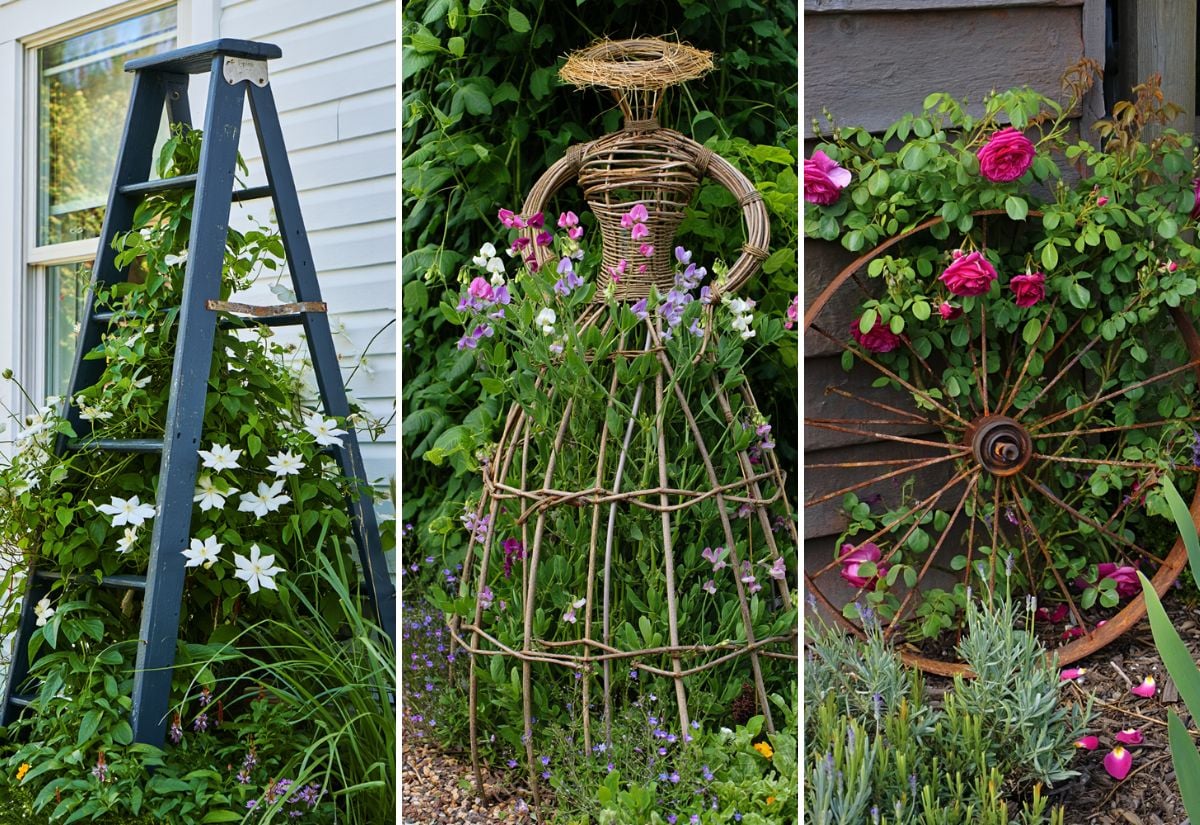Garden trellises aren’t just practical—they’re one of the easiest ways to add vertical interest, structure, and charm to any outdoor space. Sure, those ready-made trellises at the garden center are beautiful, but let’s be honest—they often come with a hefty price tag. And building one from scratch? That takes time, tools, and patience most of us don’t feel like digging into on a weekend.
So why not turn to what you already have in your sheds, garages, and curbside piles? Old tools, broken furniture, bent fencing, forgotten window frames—these overlooked items still have plenty of life left in them. With a little twine, wire, or creativity, they can become the perfect support for beans, sweet peas, cucumbers, or flowering vines.
If you’re looking for inspiration, here are 17 clever DIY trellis ideas made from cast-offs that actually work. Some of these builds take just minutes. Others are a little more playful (hello, dress form!). But every single one proves that with a little imagination, yesterday’s “junk” can grow into something truly beautiful.
1: Wire Dress Form Used as a Flower Climbing Support
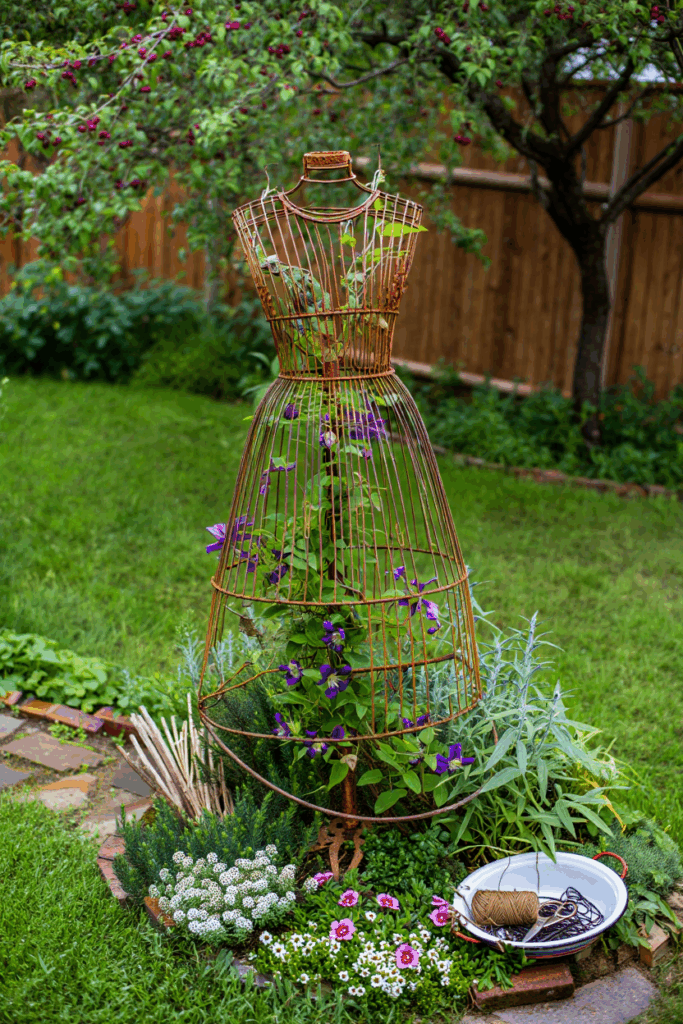
If you can get your hands on a wire dress form or vintage mannequin frame, it makes an excellent ready-to-go trellis—no construction required. To build this garden showpiece, place the form over your planting area and anchor the base using rebar or metal garden stakes driven into the ground through the wire openings. Once secured, plant clematis, black-eyed Susan vine, or even sweet peas at the base and gently weave the growing vines through the frame as they climb.
The natural curves of the dress form help guide the growth and create a layered, sculptural effect. For extra impact, stagger plantings around the base or mix varieties with different bloom times. This is a fantastic trellis idea if you want vertical interest with a touch of garden whimsy—perfect as a focal point in flower beds, herb gardens, or even by the front walkway.
2: Whimsical Scarecrow String Trellis
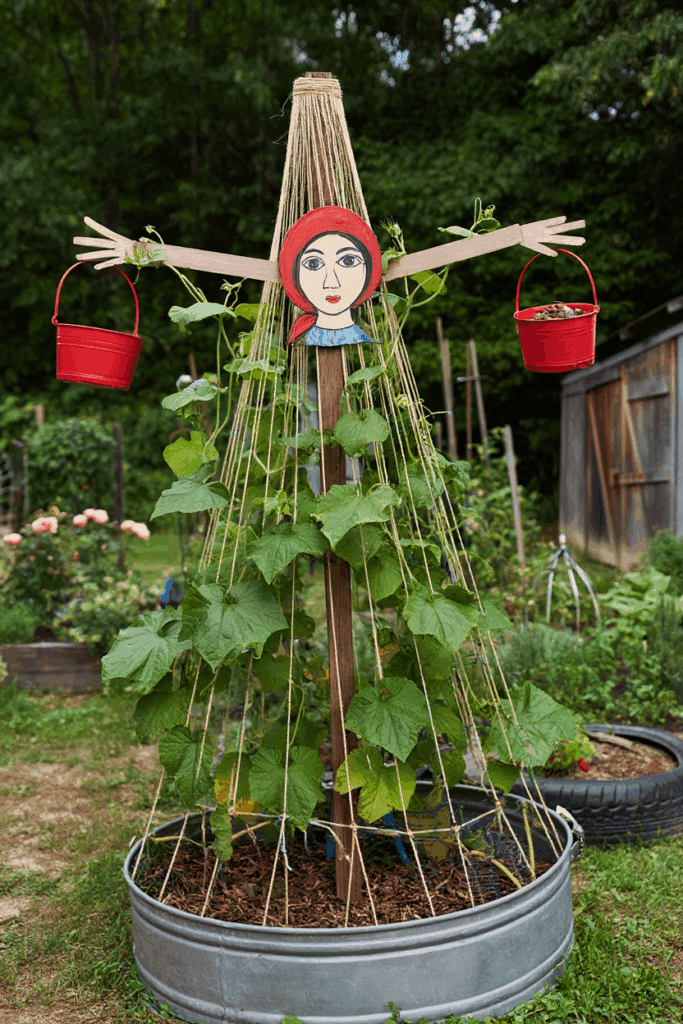
This charming structure works double duty as a whimsical focal point and a productive cucumber support. A central wooden stake forms the spine, with twine radiating out to the edges of a round metal planter. Vines easily find their way up the strings, and the round shape lets you plant in a full circle. You can keep it simple or add a bit of character—like the fun face and buckets shown here. Build it in spring and let your cucumbers, pole beans, or flowering vines climb all summer long. It’s perfect for small spaces where vertical growing makes every inch count.
3: Repurposed Door Panel Trellis
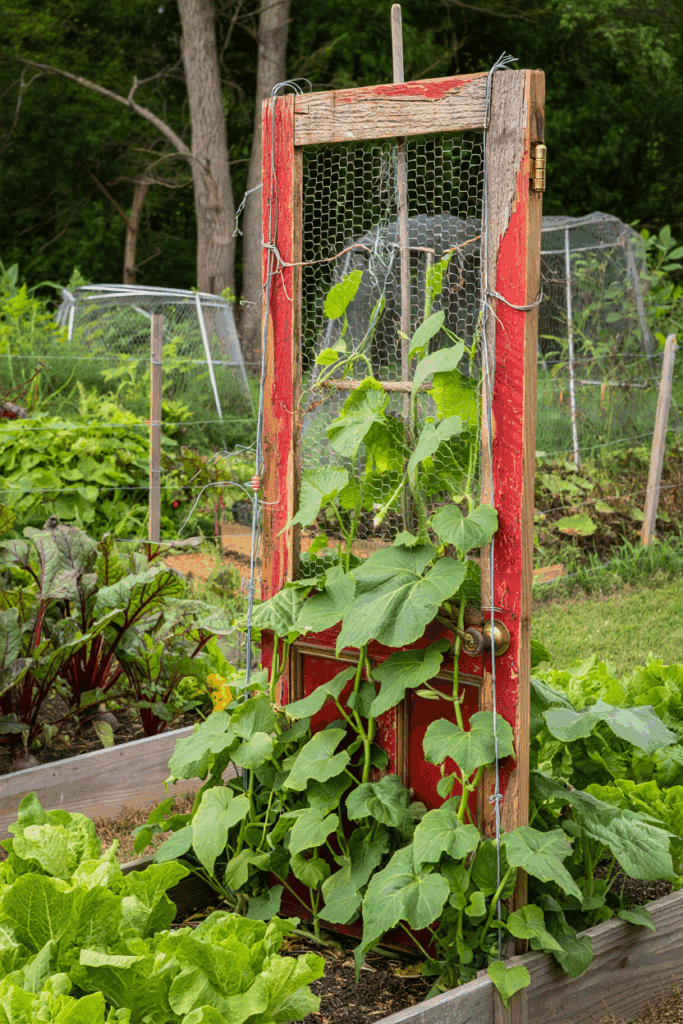
A weathered door gets new life as a bold vertical statement in the garden. Start with a salvaged wooden door—peeling paint adds charm. Replace the glass or top panel with chicken wire or garden mesh stapled securely from the back. Anchor it into the ground by burying the bottom frame several inches deep or securing it to posts for wind resistance. This upright design doubles as both support and visual backdrop. Plant vigorous growers like cucumbers or climbing zucchini along its base—by midsummer, it’ll be covered in green.
4: Wagon Wheel Trellis
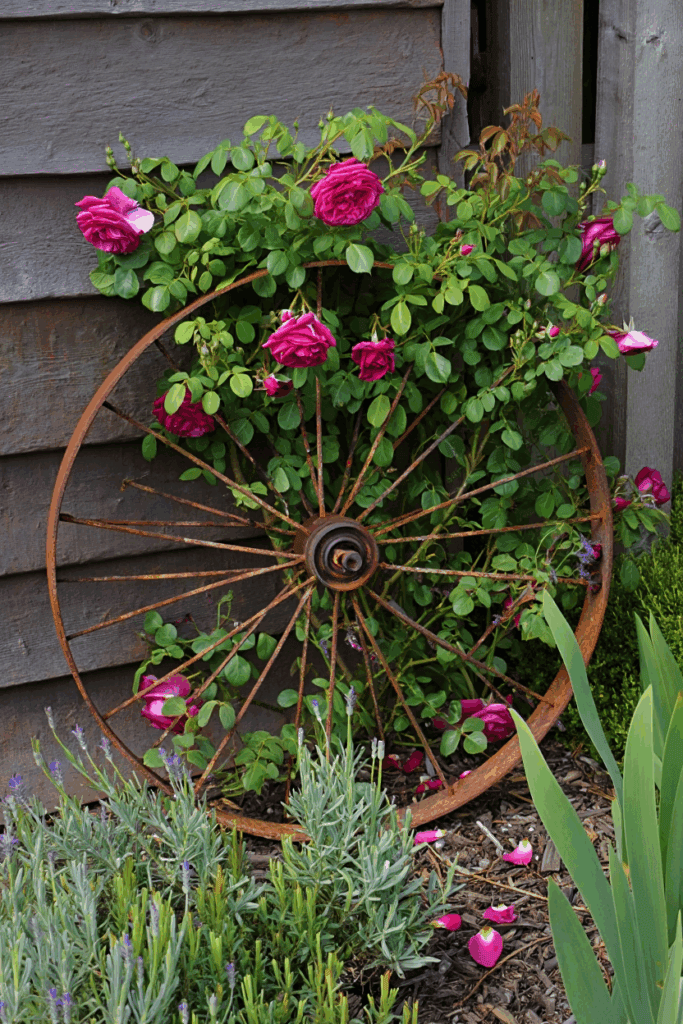
This might be the easiest trellis I’ve ever used—and one of the prettiest. All I did was lean an old metal wagon wheel against the side of my garden shed. The spokes naturally guide the vines, so there’s no need to tie anything or fuss with wires. I like using this one for climbing roses or clematis. You can wedge it in place or use rebar behind it for extra support if your vines get heavy. It’s something you can do in five minutes at the start of the season, and by midsummer, it looks like it’s always belonged there.
5: Garden Tool Teepee Trellis
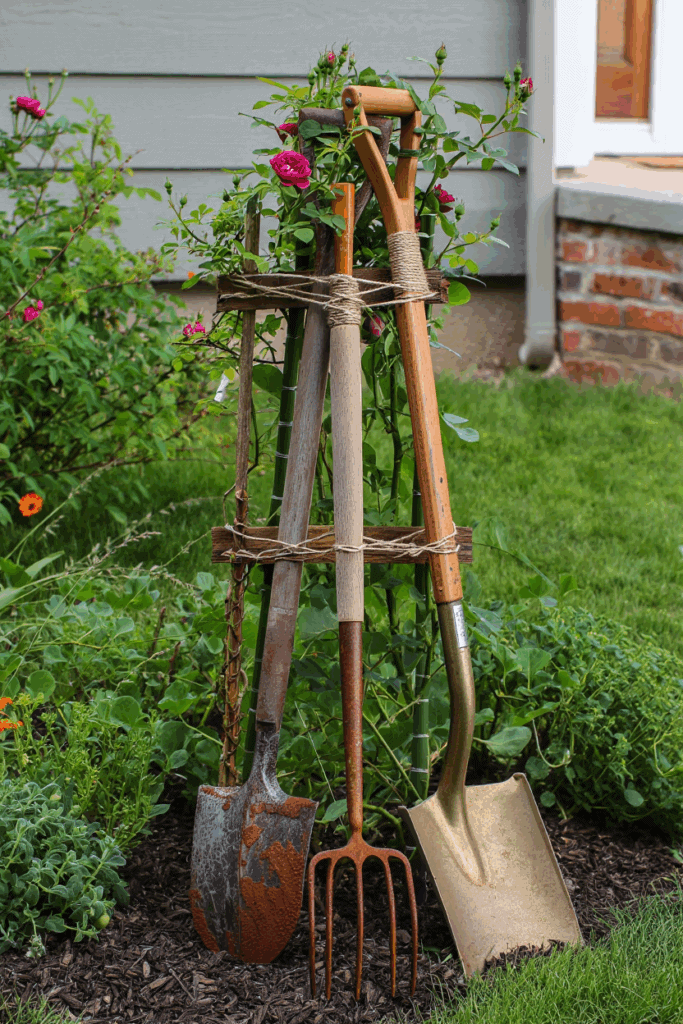
Old tools—worn spades, rakes, forks, and hoes—can be bundled together to form a teepee trellis with real character. Tie the tops securely with jute rope, and add a few horizontal supports lower down using sticks or scrap wood. The open frame gives climbing flowers like nasturtiums or sweet peas a place to twine, while the tools themselves bring a rustic, nostalgic feel. This trellis is lovely near a porch, gate, or garden path where it can be admired as it fills with bloom through the spring and summer.
6: Walker Frame Trellis for Small Vines
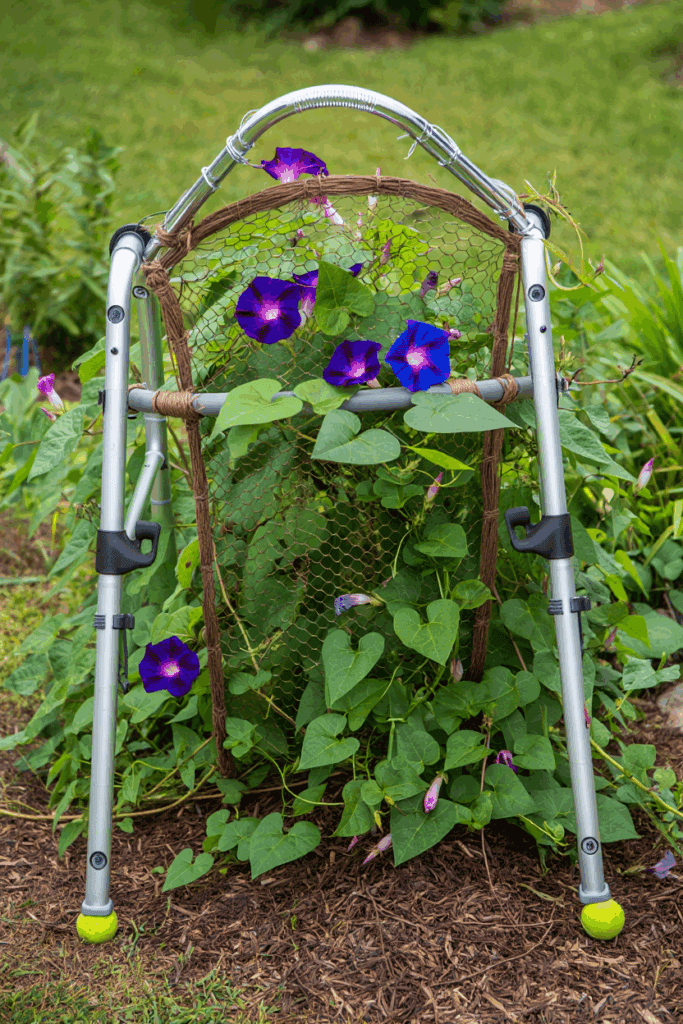
If you’ve got an old walker sitting in storage, here’s a brilliant way to give it new life. This trellis was made by stretching a panel of chicken wire across the back opening, secured with twine and tucked between the frame’s support bars. Morning glories happily take hold, curling up the mesh and handles like they were made for it. It’s stable enough to stand on its own and just the right size for small vining flowers or peas. Perfect for raised beds, patio gardens, or anywhere you need a pop of color and creativity with minimal effort.
7: Reused Garden Tools Trellis
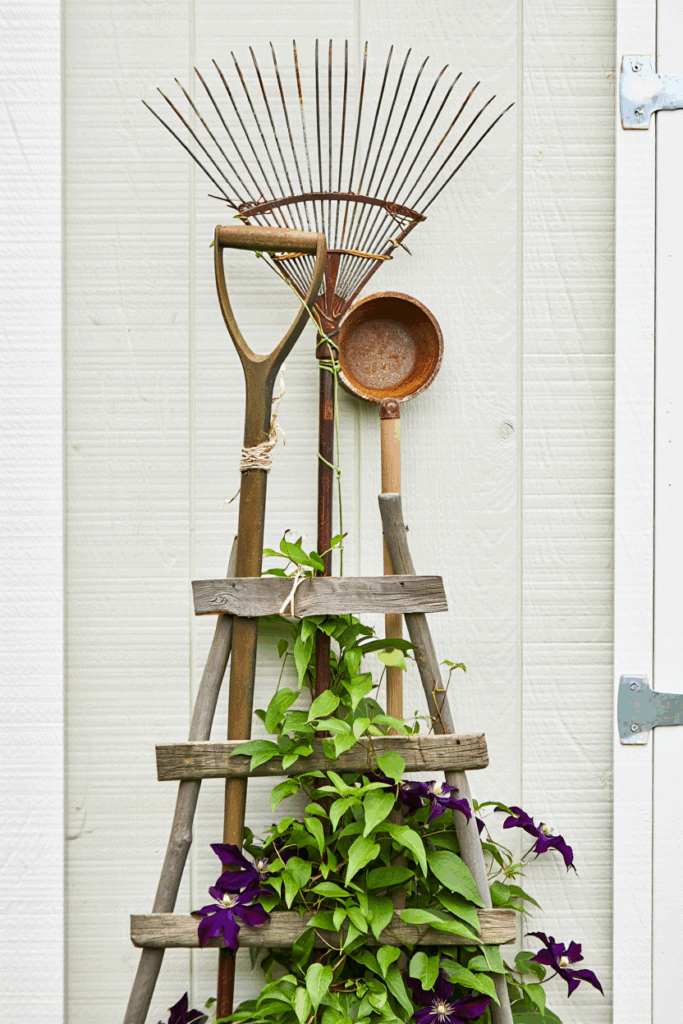
This one’s a patchwork of charm and practicality. A rake, shovel, and ladle-turned-topper come together with weathered wooden slats to form a garden-ready tripod. The vertical tools provide the structure, while horizontal wood scraps create planting tiers for climbing vines like clematis or pole beans. Use jute or wire to tie everything in place and lean it against a shed, wall, or fence for added support. This setup not only gets your tools out of storage but turns them into something beautiful and useful—especially great in vintage or cottage-style gardens.
8: Bike Wheel Trellis for Vertical Gardens
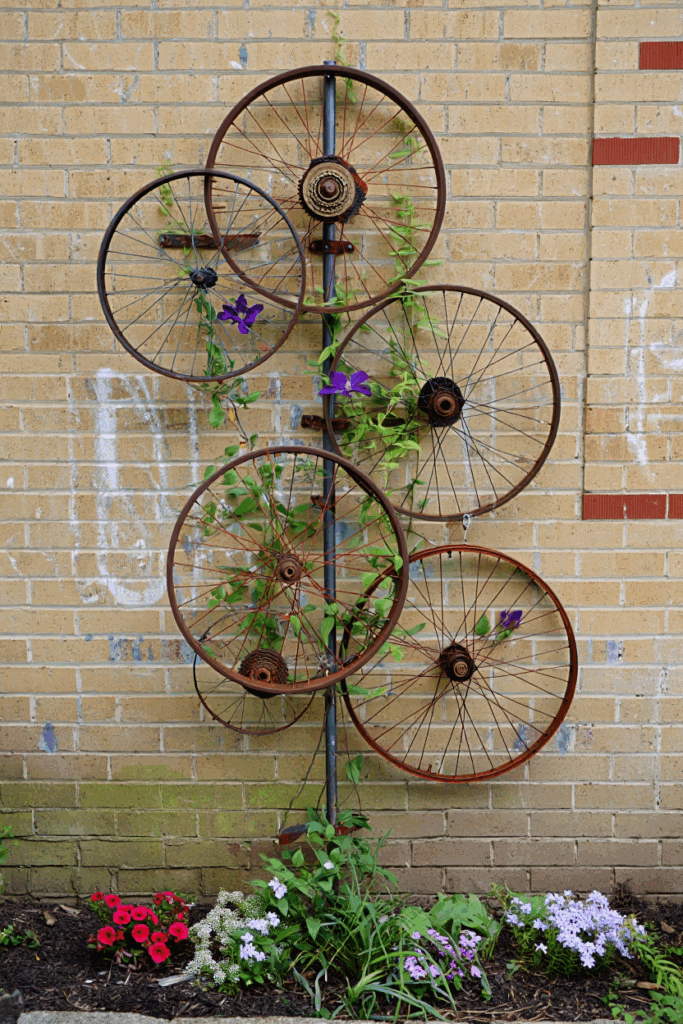
A stack of old bike wheels can be turned into a trellis wall that’s both strong and surprisingly stylish. Start by attaching the wheels to a long post or directly to a fence using screws, hooks, or wire. Arrange them in a vertical line or stagger them for a layered look. The spokes give vines something to grab without any added mesh. This structure works well for flowering climbers like clematis, sweet peas, or climbing nasturtiums. It’s best built at the start of the season so vines have time to fill in. Use this along a sunny wall that needs a bit of life or in narrow beds where ground space is limited.
9: Trellis Out of Repurposed Headboards
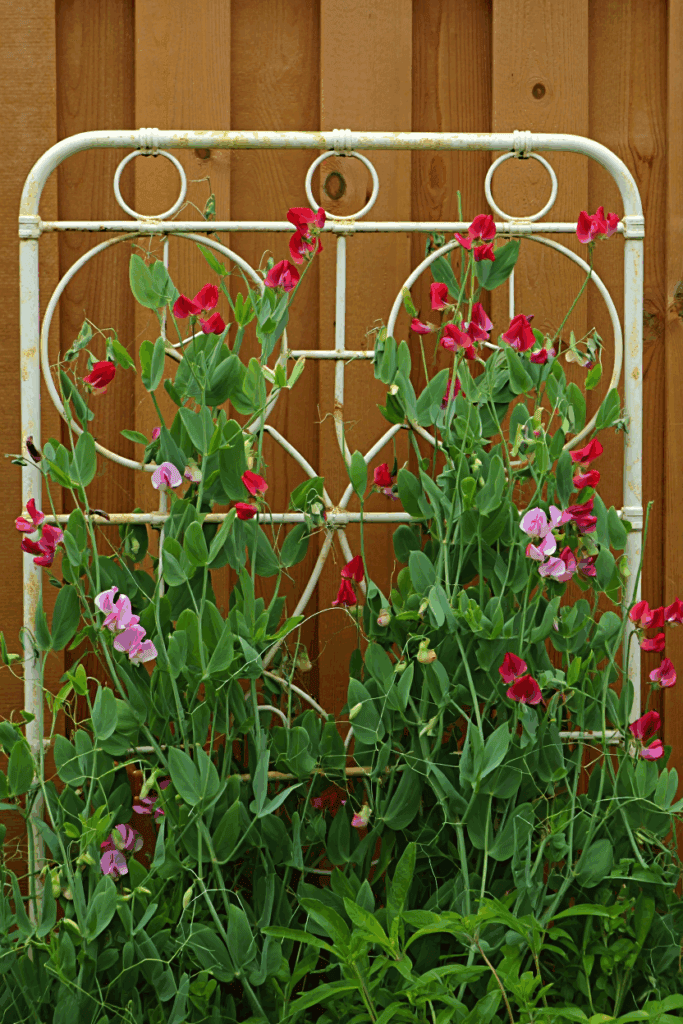
An old metal bed headboard doesn’t need much tweaking to become a sturdy, decorative trellis. Just push it into the ground behind your garden bed, and you’ve got instant vertical support for climbing flowers like sweet peas or beans. The loops and bars provide natural footholds for tendrils, while the curved top adds vintage appeal. This is especially handy in cottage gardens or along fences where you want to bring in a bit of old-world charm. Paint it or leave it rustic—either way, it holds up beautifully through the seasons.
10: Step Ladder Turned Garden Climber
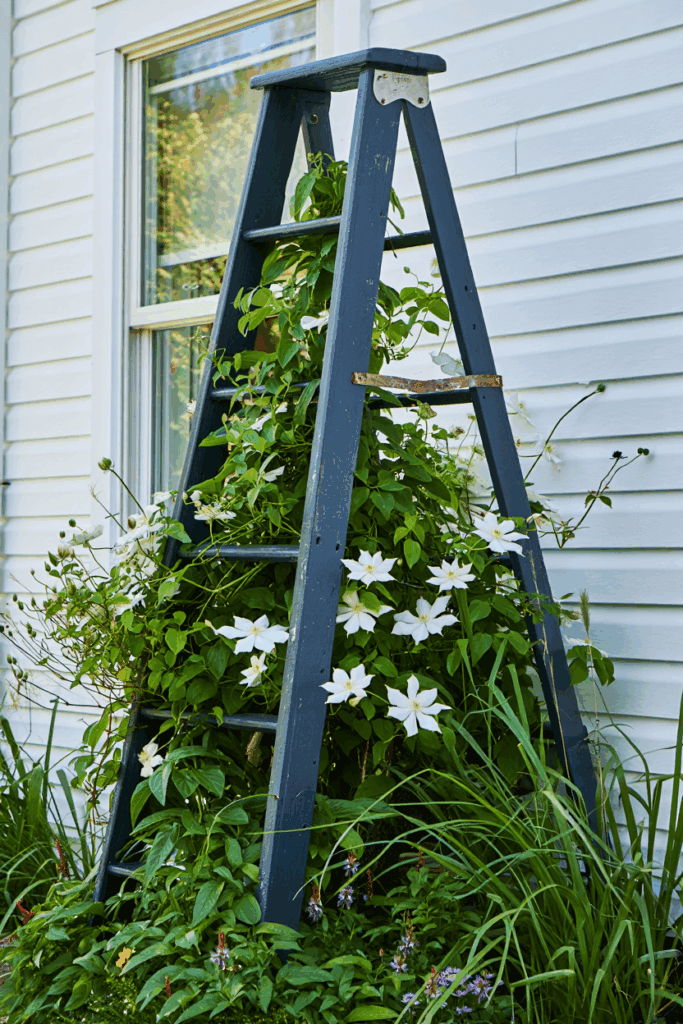
An old wooden ladder becomes garden gold when you lean it against a sunny wall and let the vines go wild. This one’s been painted bright green for an extra pop, but any old ladder will do—wooden ones work best since they give tendrils something to grip. Position it near a climbing plant like honeysuckle or black-eyed Susan vine, and the steps provide instant horizontal rungs for upward growth. Great for garden corners or tight spots where you want something upright, easy, and eye-catching.
11: Trellis Made from a Woven Dress Form
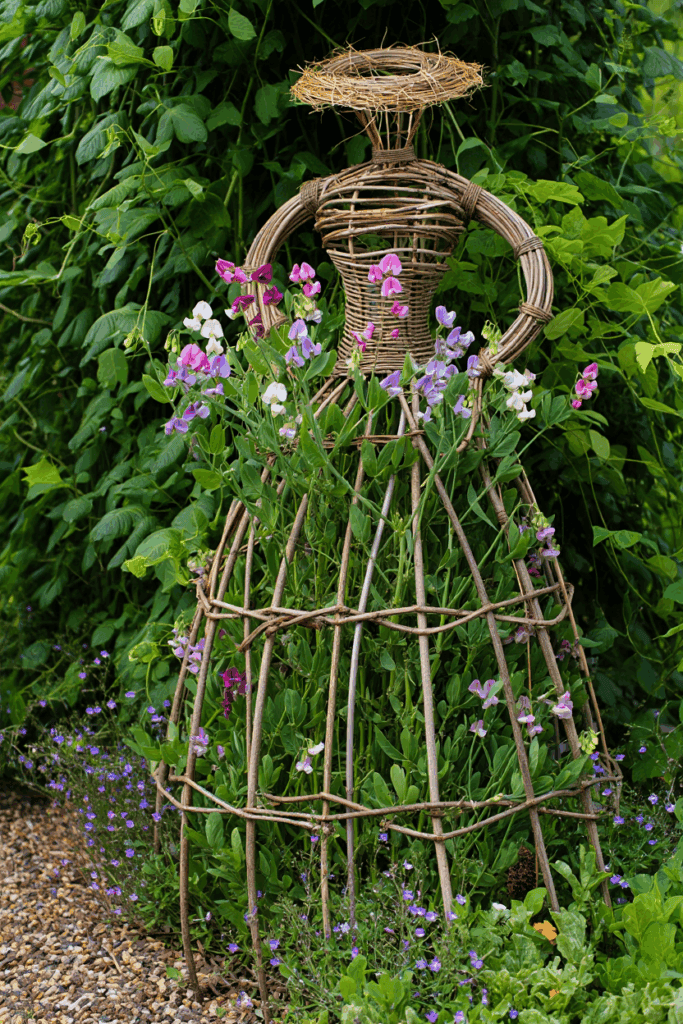
It’s part sculpture, part support system—and 100% showstopper. This trellis is crafted from bent willow into a dress form, giving flowering vines like sweet peas a frame to grow through and around. The hollow interior provides vertical support, while the outer structure keeps the look tidy and shapely. It works beautifully as a focal point in flower beds or tucked into the curve of a cottage path. It’s a bit whimsical, a bit rustic, and totally worth the time if you want something beyond the usual tomato cage.
12: Upcycled Birdcage as a Flower Tower
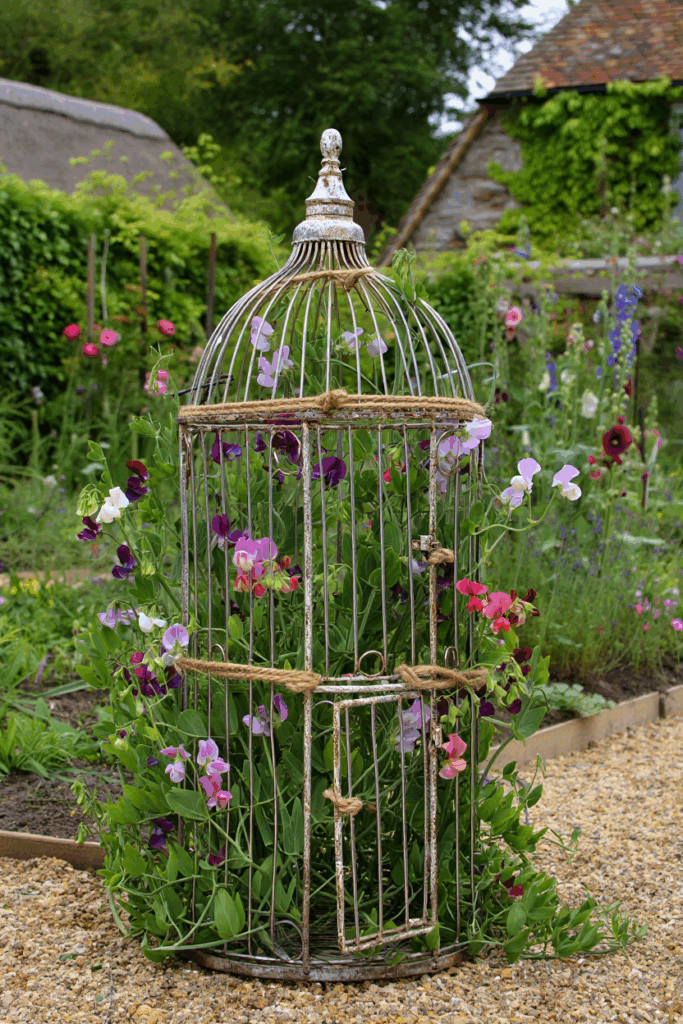
You don’t need to weld or build anything when you’ve got a vintage birdcage lying around. Just place it directly into your flower bed, open the base if needed, and let climbers like sweet peas, black-eyed Susan vine, or nasturtium weave through the bars. The domed top and round shape keep growth contained while adding serious charm. If the cage is rusty or flaky, leave it that way—it adds to the storybook feel. Use this in beds where space is tight but you still want vertical bloom and character.
13: Old Garden Gate Used as a Folding Trellis
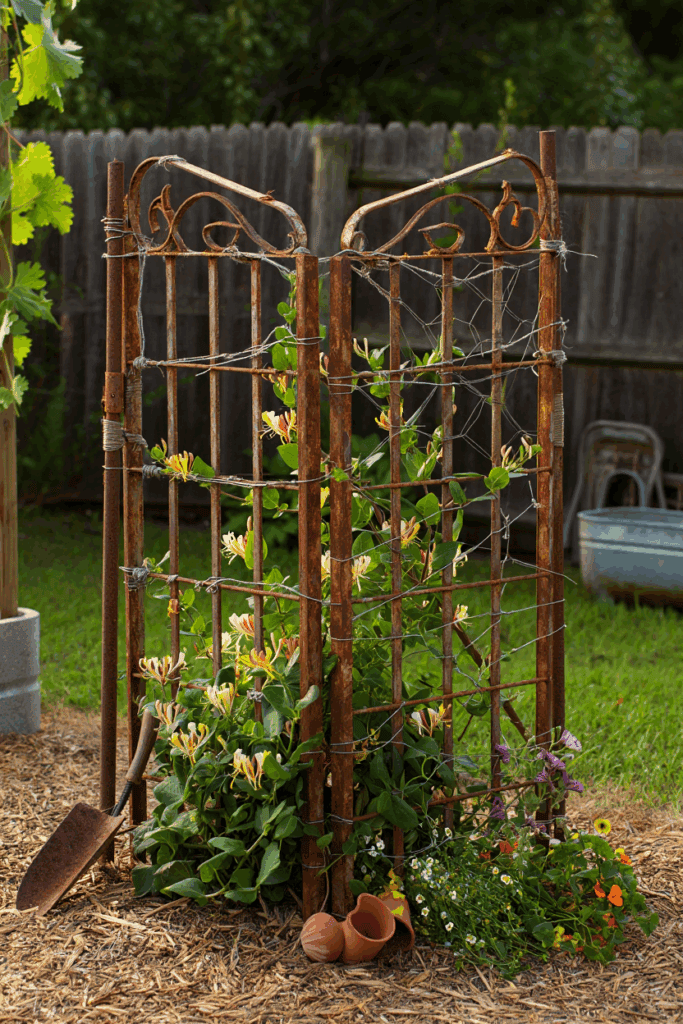
Forget hauling this to the scrapyard—an old iron garden gate can become one of your most beautiful climbing supports. Hinged together into a freestanding screen, this gate uses its existing bars to hold up heavy vines like honeysuckle. Wire mesh adds extra support while the rusted finish gives it a classic weathered look. Use it as a divider between garden zones or place it against a wall as a bold focal point. A perfect blend of structure and style for rustic gardens.
14: Umbrella Frame Repurposed for Wisteria
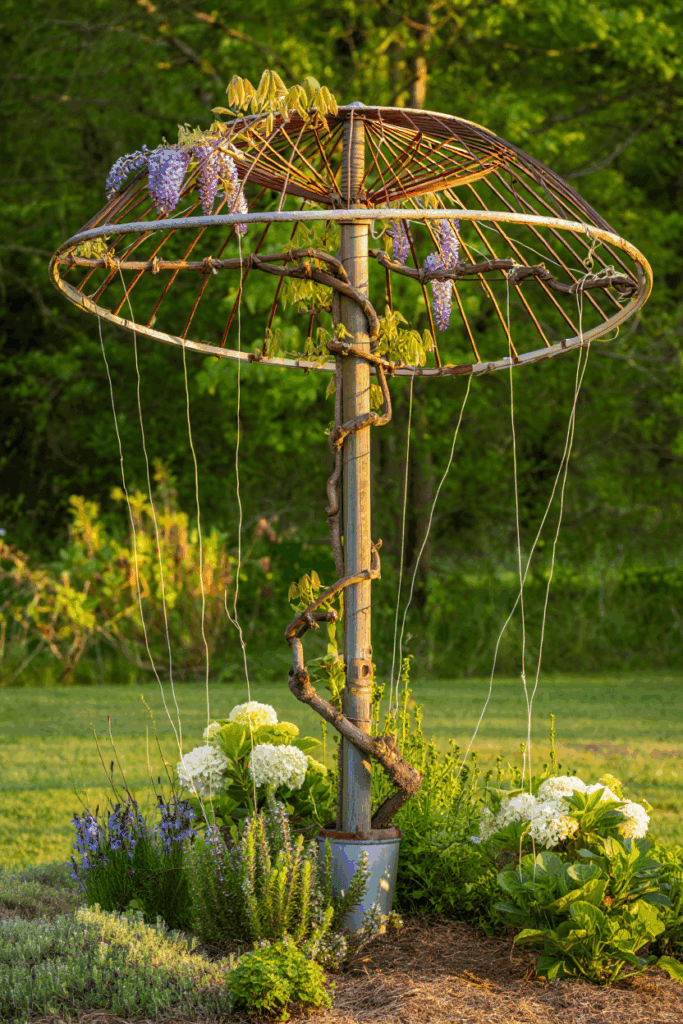
An old patio umbrella skeleton, flipped and mounted on a center pole, becomes a striking canopy trellis for large flowering vines like wisteria or hyacinth bean. String ties hang down from the frame’s ribs to guide vines upward, while the umbrella shape forms a shaded floral dome as plants mature. It’s especially beautiful in a circular bed or as a focal point in an open lawn. Just make sure the central post is deep and sturdy—this one’s meant to anchor something bold and beautiful.
15: Window Frame Used as a Trellis
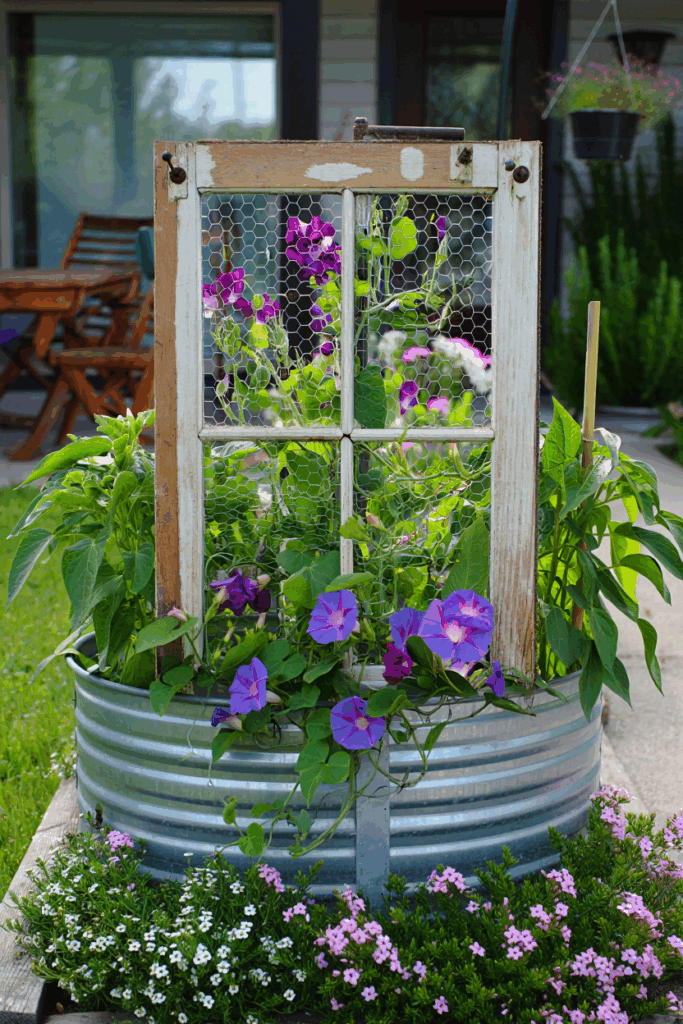
If you’ve got an old wooden window frame—without the glass—you can turn it into a charming vertical support in just a few steps. Start by stapling chicken wire or hardware cloth across the back side of the frame. This gives vines something to grip. Then push the base of the window frame a few inches into the soil inside a raised bed or large planter. For added stability, screw it directly into the planter sides or brace it with wooden stakes behind. This type of trellis is best for lighter climbers like sweet peas or morning glories. It’s ideal when you want a little height in a container garden without building something from scratch.
16: Old Fan Guard Turned Into a Circular Trellis
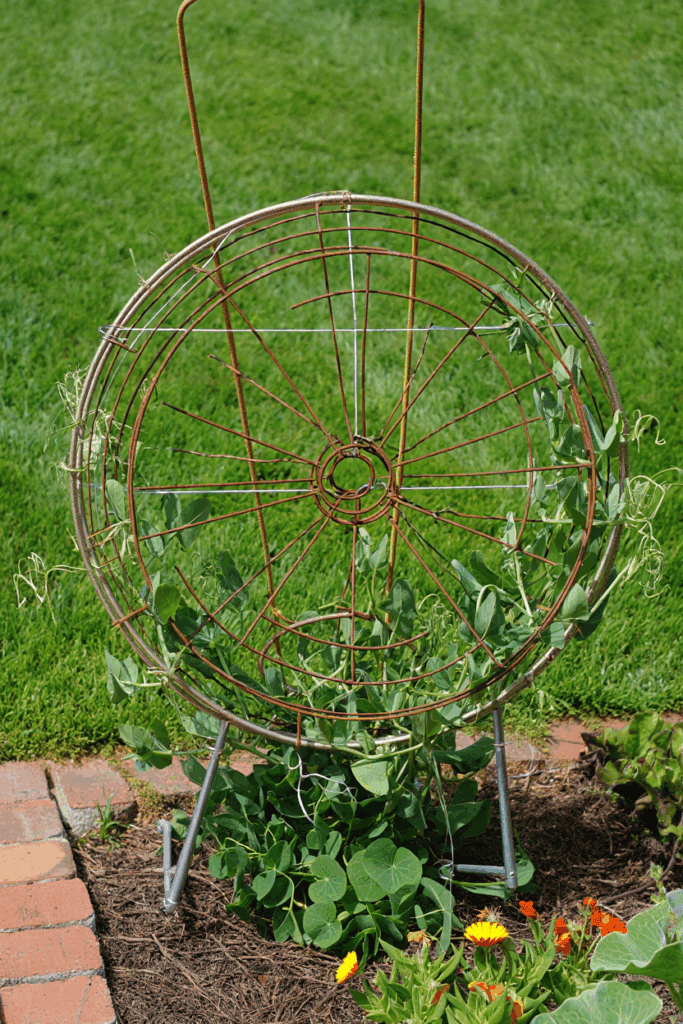
That round fan guard you’ve been storing? It’s already halfway to being a trellis. To make this work, set the guard vertically in your garden bed and attach it to two rebar stakes or heavy wooden dowels using wire or zip ties. Make sure it’s firmly anchored so it won’t wobble in the wind. Plant peas, nasturtiums, or other small twining vines at the base, and they’ll naturally climb the metal spokes. It works especially well in small beds where you need a narrow but tall support. The shape creates a nice visual element while keeping your plants growing upward and off the ground.
17: Metal Garden Chair Repurposed as Trellis
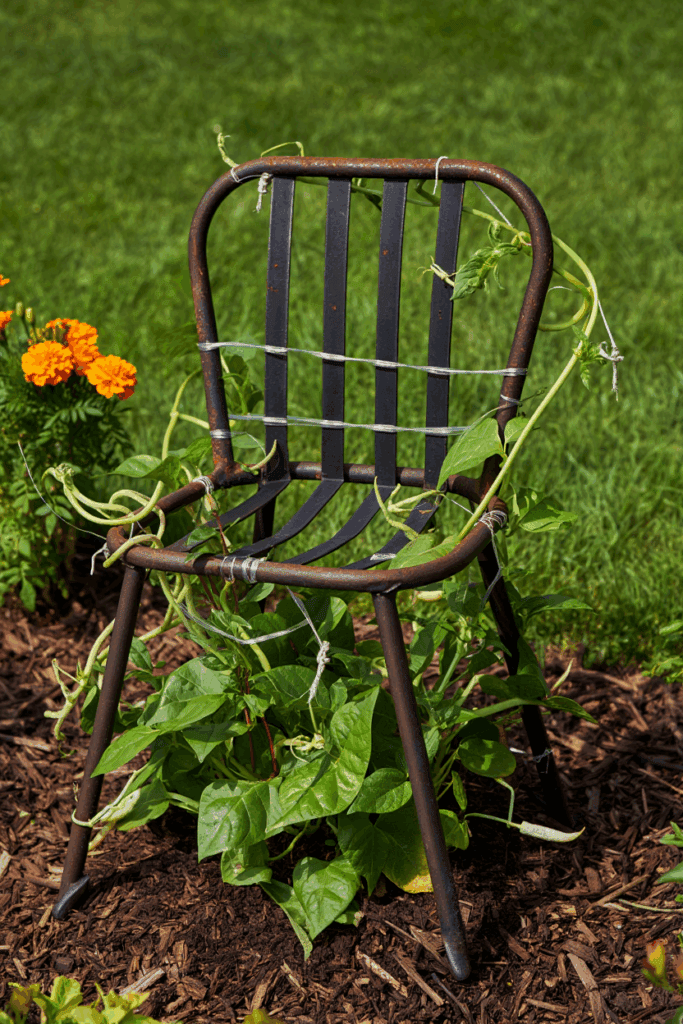
Old metal chairs with slatted backs or open designs make surprisingly good trellises. Just place the chair directly into your garden bed, making sure it’s sturdy and won’t tip. You can tie a few lengths of twine across the backrest or arms to give your plants even more to climb. Then plant pole beans or other climbers like hyacinth bean vine around the legs. As the vines grow, they’ll wrap naturally around the frame.

